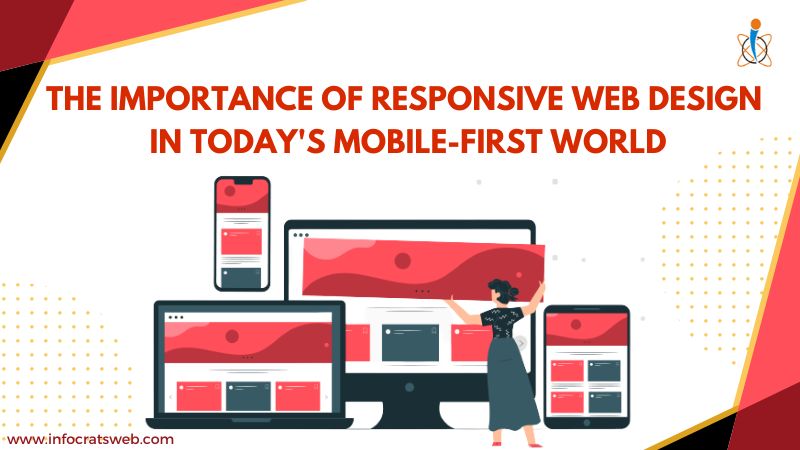It is crucial for businesses to adapt to the mobile-first world today. Responsive web design as well as mobile-friendly design have emerged as essential elements to provide a seamless browsing experience across all devices. This blog will talk about the significance of a responsive web design and why it is imperative for businesses to prioritize mobile-friendly design.
Responsive Web Design
Responsive web design is an approach that aims to create websites that adapt and respond to the user’s screen size, orientation, as well as platform, ensuring optimal viewing experience across multiple devices. It involves designing and developing websites that automatically adjust their layout, images, and content based on the screen size and resolution. By incorporating flexible grids, images, and CSS media queries, responsive web design enables a website to be easily accessible on desktops, laptops, tablets, and smartphones.
Mobile-Friendly Design Gaining Importance
In today’s mobile-first world, mobile-friendly design is gaining paramount importance in mobile app development. With the majority of internet users accessing websites through mobile devices, businesses cannot afford to overlook the significance of optimizing their websites for mobile. Mobile-friendly design ensures a seamless and enjoyable browsing experience for users on smartphones and tablets. It includes responsive layouts, touch-friendly interfaces, and fast loading times. By prioritizing mobile-friendly design, businesses can cater to the growing mobile audience, improve user engagement, and stay ahead in the competitive digital landscape.
Enhanced User Experience
One of the primary reasons responsive web design is crucial in today’s mobile-first world is because it significantly enhances the user experience. Users expect websites to load quickly and provide a seamless browsing experience, regardless of the device they are using. With responsive design, websites can automatically adjust their layout, eliminating the need for users to pinch, zoom, or scroll horizontally to view content. By providing a consistent and optimized user experience, businesses can improve engagement, reduce bounce rates, and increase conversions.
Responsive web design also ensures that content is displayed in a user-friendly manner, with proper alignment, readable text, and appropriately sized images. It eliminates the frustration of having to navigate through a cluttered and distorted website on a mobile device. By providing a visually appealing and intuitive interface, businesses can leave a positive impression on users, increasing the likelihood of repeat visits and fostering customer loyalty.
Search Engine Optimization (SEO) Benefits
Responsive web design plays a pivotal role in search engine optimization (SEO). Search engines like Google prioritize mobile-friendly websites in their search results, as they want to provide the best user experience to their mobile users. Responsive design ensures that businesses have a single website URL, making it easier for search engines to crawl and index the content. Additionally, responsive websites tend to have lower bounce rates, higher average session durations, and improved mobile user engagement, all of which positively impact SEO rankings.
Having a separate mobile version of a website can lead to duplicate content issues and dilute the SEO efforts. With responsive design, businesses can consolidate their SEO strategies and focus on a single website that caters to all devices. This streamlined approach saves time and resources that would otherwise be spent on managing and optimizing multiple versions of the same content. Furthermore, responsive websites are more likely to receive backlinks and social shares, further boosting their search engine rankings. To take benefits if search engine optimization you can hire digital marketing company which are experts in this industry.
Cost and Time Efficiency
Having a separate mobile version of a website can be time-consuming and expensive to develop and maintain. With responsive web design, businesses can eliminate the need for creating and managing multiple versions of their website. Designing a single responsive website that caters to all devices not only saves time but also reduces costs associated with website development and maintenance. This cost and time efficiency make responsive design an attractive option for businesses of all sizes.
Moreover, updates and changes can be implemented seamlessly across all devices with responsive design. Instead of making modifications separately for desktop and mobile versions, businesses can make universal updates that instantly reflect on all devices. This streamlined process not only saves time but also ensures consistency across different platforms, eliminating the risk of content discrepancies.
Additionally, responsive web design reduces the need for constant device-specific testing. With a single responsive website, businesses can focus their testing efforts on one platform, ensuring that the website functions flawlessly across different devices and screen sizes. This simplifies the testing process and allows businesses to allocate their resources more efficiently.

Future-Proof Solution
The technology landscape is constantly evolving, with new devices and screen sizes being introduced regularly. By adopting responsive web design, businesses future-proof their online presence. Responsive websites can easily adapt to new devices and emerging technologies, ensuring that the user experience remains consistent and optimal. Rather than having to redesign and develop new versions of their websites every time a new device is released, businesses can rely on their responsive design to seamlessly adapt to the changing technological landscape.
Responsive web design also caters to the increasing popularity of wearable devices, such as smartwatches and fitness trackers. These devices have small screens and unique interaction methods, requiring websites to adapt to their limitations. With responsive design, businesses can ensure that their websites are accessible and functional on wearable devices, providing a consistent user experience across all types of devices.
Competitive Advantage
In today’s highly competitive digital landscape, staying ahead of the competition is crucial for businesses. Responsive web design offers a significant competitive advantage by providing an optimized user experience across all devices. Users are more likely to engage with websites that are user-friendly, visually appealing, and easily accessible on their preferred devices. By investing in responsive design, businesses can stand out from their competitors, attract more visitors, and increase customer satisfaction and loyalty.
Furthermore, a mobile-friendly website is increasingly becoming a consumer expectation. Users have become accustomed to seamless mobile experiences, and a non-responsive website can leave a negative impression on potential customers. A poorly optimized website may result in higher bounce rates and lost opportunities for conversions. By implementing responsive web design, businesses can meet customer expectations, build trust, and create positive brand experiences.
In today’s mobile-first world, responsive web design as well as mobile-friendly design have become indispensable for businesses. By prioritizing responsive design, businesses can provide a consistent, engaging, and user-friendly experience across all devices. From enhanced user experience and improved SEO rankings to cost and time efficiency, the benefits of responsive web design are numerous. Embracing responsive web design is not just a trend but a necessity to succeed in the highly competitive digital landscape. By adapting to the evolving needs and preferences of users, businesses can future-proof their online presence and gain a competitive edge in the market.









